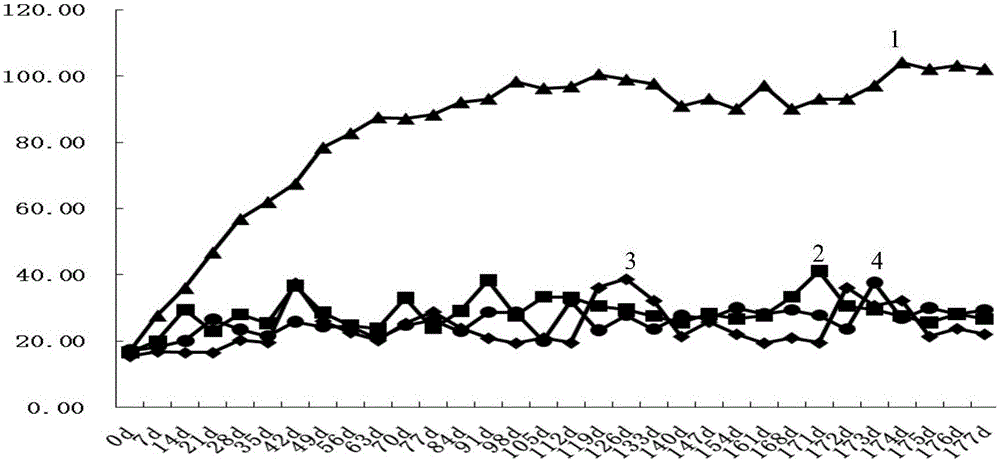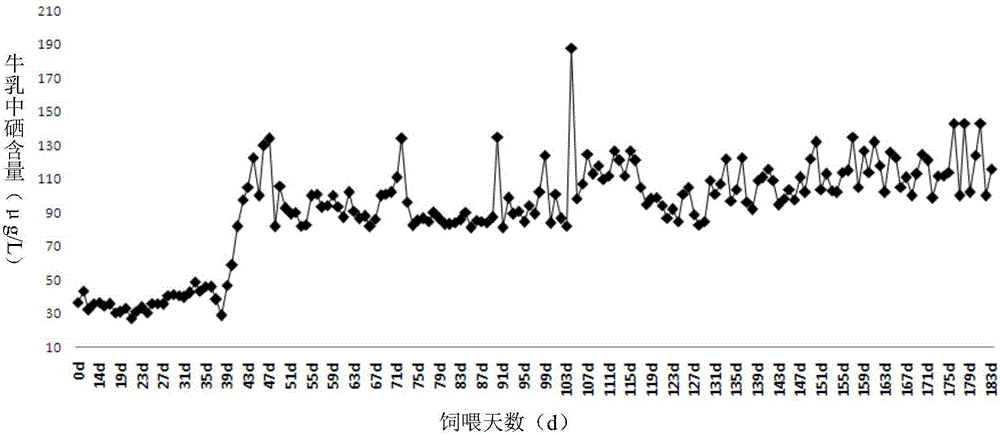Method for raising cows capable of producing selenium-rich milk
A selenium-enriched, dairy cow technology, applied in animal feed, animal feed, milk preparations, etc., can solve the problems of incomplete absorption, unsustainable long-term production of selenium-enriched milk, and inability to achieve the best effect of nutrition and health care. low cost effect
- Summary
- Abstract
- Description
- Claims
- Application Information
AI Technical Summary
Problems solved by technology
Method used
Image
Examples
Embodiment 1
[0041] Example 1 Screening of the most suitable selenium source
[0042] The inventors selected 10 types of 2 types of yeast selenium products on the market. Among them, one type of organic selenium sources are mainly Candida utilis and Candida tropicalis; the other type, organic selenium sources are mainly Saccharomyces cerevisiae. Selenium-enriched yeast was added to the conventional feed at a dose of 30 mg / head, and each product was fed to 10 dairy cows entering the lactation period for 30 days. The selenium content in the milk produced by the cows during and after the feeding was determined during the feeding process. The results showed that the content of selenium in milk produced by cows fed with selenium-enriched yeast from Candida utilis and Candida tropicalis did not change significantly. However, the changes of selenium in milk produced by cows fed with organic selenium derived from brewer's yeast were significant. Among them, the experimental group fed with Selen...
Embodiment 2
[0044] Example 2 Production test of selenium-enriched milk with different yeast selenium additions
[0045]In order to sample the long-term feeding effect of adding selenium-enriched yeast and the production stability of selenium-enriched milk produced by dairy cows, in this example, the inventor selected 844 healthy, normal growth and development lactating dairy cows. Based on the principle of similar calf days, the experimental cows were divided into 4 experimental groups with 211 cows in each group. The control group was fed selenium-enriched fungus chaff feed, and the low-dose organic selenium, medium-dose organic selenium and high-dose selenium supplemented groups were fed. Feed different levels of yeast selenium. Different selenium sources were evenly mixed into the feed for feeding. The specific experimental groups are:
[0046] Test grouping:
[0047] The amount of organic selenium fed in the diet of the low selenium dose selenium supplement group: 5-10 mg / head day....
Embodiment 3
[0063] Example 3 Stability test of dairy cows producing selenium-enriched milk
[0064] In order to solve the problem of poor stability of selenium-enriched milk produced by dairy cows and large fluctuation of selenium content in milk. The inventors made adjustments to the cow feeding process during lactation. The experiment selected 726 healthy, normal growth and development lactating dairy cows. According to the principle of similar age, parity, milk production and calving days, there were 4 cowsheds in the experimental group, with 182 cows in each group. The dosage of organic selenium was selected as The middle dose group of Example 2. During the feeding process of the previous year, the inventor accidentally found that the content of selenium in the milk produced by changing the dosage of vitamin E, zinc sulfate monohydrate and manganese sulfate monohydrate during the feed addition process increased to some extent, and the selenium content increased to a certain extent. ...
PUM
 Login to View More
Login to View More Abstract
Description
Claims
Application Information
 Login to View More
Login to View More - R&D
- Intellectual Property
- Life Sciences
- Materials
- Tech Scout
- Unparalleled Data Quality
- Higher Quality Content
- 60% Fewer Hallucinations
Browse by: Latest US Patents, China's latest patents, Technical Efficacy Thesaurus, Application Domain, Technology Topic, Popular Technical Reports.
© 2025 PatSnap. All rights reserved.Legal|Privacy policy|Modern Slavery Act Transparency Statement|Sitemap|About US| Contact US: help@patsnap.com



